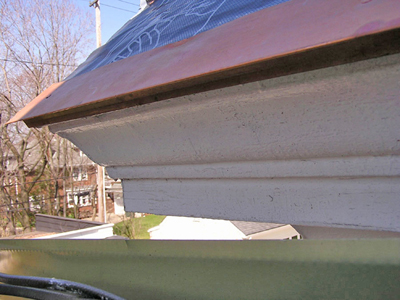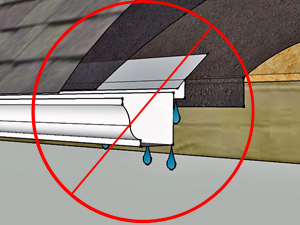
Custom fabricated drip edge to prevent water behind gutter.
- Category: Drip Edge
- Written by Dennis Crookshanks
Video:
Drip Edge | Gutter Flashing
Installing custom drip edge to prevent water dripping behind a gutter.
Water stains, dirt, debris and dripping water behind a gutter are usually the result of poorly installed or missing drip edge. Most premade drip edge flashing at home improvement and roofing supply stores is only available in one or two sizes. This is fine for some houses, but often the rain gutters are hung at different heights and angles on the gutter board to facilitate proper drainage. This leads to a gap between the gutter and the drip edge, where rain can splash up against the gutter board and run behind the gutter. The rain water splashing up on this gutter board is not only causing unsightly streaks on the wood below, but it is also soaking the gutter board which will eventually lead to rotting of the wood. Even though the slate roofing shingles are extended past the gutter line properly, the water dripping off the roofing can be blown against the gutter board in high winds.
A professional roofer, with the proper tools and experience, will be able to fashion custom drip edge or gutter apron from sheet metal stock to prevent this problem. Custom fabricated on a professional metal bending brake, this new drip edge flashing protects the gutter board and prevents water from dripping behind the rain gutter.
Drip edge is an essential part of a properly installed roofing system that will help to enhance the beauty of your home as well as protect it from leaks and water damage.
On the eaves of the home drip edge will protect the fascia or gutter board from wind blown rain and water splashing from the gutter on to the roof boards. It will also help to support roof shingles from drooping into the gutter or being broken from falling tree limbs.
On the rake or gable edges of the roof, it protects the wood trim and roof decking from wind blow rain and also protects the roofing shingles from being lifted up and torn off the roof by strong winds.
On the edges of the roof, drip edge will cover the uneven gaps between the wood or siding trim and the roof shingles, giving the roof a smooth clean edge line.
Not all drip edge is the same.
There are different types of drip edge for use on various roof styles as well as slightly different installation methods for differing areas of the roof.
A pre formed metal edge may work fine on a roof with crown moulding at the eave, but a steeply pitched roof may need a custom bent metal edgeing to fit the angles of the roof and gutter board.
Also, in areas of the country prone to ice and water damming issues, it is a better idea to install the drip edge sandwiched between two layers of ice and water shield membrane than to install the edging under the membrane.
Drip edge:
Drip Edge - Type and Applications
- Category: Drip Edge
- Written by Dennis Crookshanks
Drip edge comes in two types; A "T" shape drip edge that extends out over the edge of the roof decking. Particularly useful with bracketed half round rain gutters which are held out a small distance from the fascia / gutter board. And "L" shape drip edge, which hugs the edge of the roof deck and is used most often with flange back rain gutters.
Home store drip edge is usually made of aluminum or galvanized steel.Sometimes painted, usually white or brown. The aluminum is usually the thinnest grade available. Very flimsy and easily dented. The galvanized drip edge is also of the lightest guage and electroplated with a thin layer of zinc plating.
Roof Drip Edge | Is it always necessary
- Category: Drip Edge
- Written by Dennis Crookshanks
Should you install drip edge flashing on all edges of your roof?
The importance of drip edge installation depends mostly on the type of wood used for the roof deck and how much water is likely to come into contact with that wood. Proper drip edge installation can prevent soffit and roof deck damage.
Drip edge and water leaking behind gutter.
- Category: Drip Edge
- Written by Dennis Crookshanks
Stop rain water from dripping between the gutter and fascia board.
Drip edge flashing is used at the eave or edge of the roof to protect the fascia board from water damage and rot.

Unfortunately it is often installed wrong.


